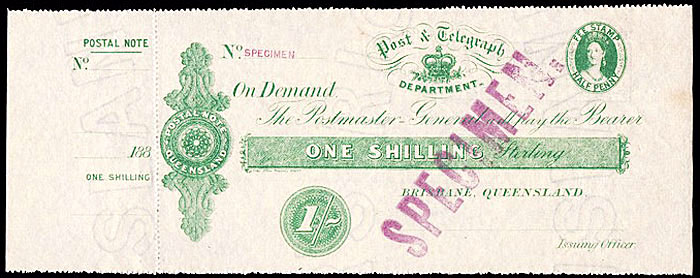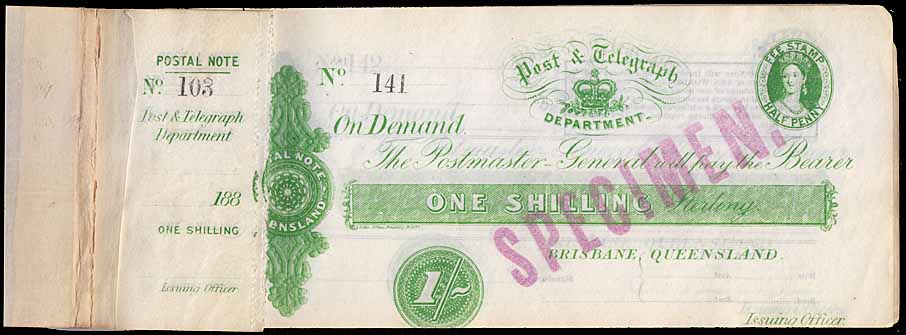Ordinary rate transmission form: QC-TO-5.
- Site home & details
- Australia 1901-1988
- New South Wales
- Queensland
- South Australia
- Tasmania
- Victoria
- Western Australia
- International
- Special aspects
| Heading and notes: | Post & Telegraph Department. POSTAL NOTE 1/-. |
| Front: | Information. |
| Reverse side: | Message area of three lines after the address. |
| Colours (text & form): | Green on white. |
| Size of form overall: | 80 × 205 mm including counterfoil of 47.5 mm. |
- unique experiment with postal note value of 1/. The amount could be used either to pay the cost of an inland telegram of up to 10 words or to collect a 1/-;
- the paper is very thin with a strong watermark
ELECTOR'S RIGHT/QUEENSLAND or QUEENSLAND/POSTAL NOTE; - a complete unused form has the Postal Note and a tab at the left which was bound into a booklet;
- all variations have an image similar to that for the Chalon stamps;
- issued in October 1880.
The 5th type of Queensland transmission form is a sub-set of the larger issue of the Queensland Postal Notes. Hence the details of the 1/- transmission form must be presented with reference to the details of the other printings of the 1/- note:
- Background to the issue of the Postal Notes and the use for telegrams;
- Overall approach to printing the Postal Notes;
- First printing (QC-TO-5A);
- Second printing (QC-TO-5B);
- Third printing (QC-TO-5C);
In the Brisbane Courier of 30 October 1880:
"new regulations in connection with the issue and sale of postal cards and postal notes under the provisions of the Act recently passed are published in to-day's Government Gazette and both cards and notes will be issued at the General Post Office on and after Monday.
The postal notes are of four classes, each distinguished by a different color:
- the shilling note being printed in green ink;
- the half-crown in red;
- the five shillings in blue; and
- the ten shillings in lilac.
They are lithographed at the Government office and both design and execution are creditable to the department.
For the present, postal notes will only be issued at the General Post Office but, after December 1, they will be obtainable at the post offices at Ipswich, Toowoomba, Warwick, Dalby, Roma, Maryborough, Rockhampton, Blackall, Aramac, Clermont, Mackay, Bowen, Townsville, Charters Towers and Cooktown. These offices, together with the General Post Office in Brisbane, will be the paying ones and we understand that in course of time other offices will be appointed wherever banking accommodation is to be obtained in the same town.
It is not, however, anticipated that every person who receives a postal note will at once go to the nearest post office and get it cashed, but it is more likely that it will be found convenient in the bush to use the notes as change, the store-keepers and others who receive them for goods taking them to the post office whenever they have accumulated any number. A note if desired may, for the sake of additional security in transmission, be made payable only to the person to whom it is sent by endorsing the name of the recipient across the face; but otherwise every note will be payable to the bearer on demand.
The numerous ways in which such notes may be made convenient to the public will readily suggest themselves, but we may mention one that has been brought under our notice - namely, that of paying rates to a divisional board at a distant town where perhaps there may be no money-order office. We understand that already a number of the boards have applied for the establishment of money-order offices for this purpose, but now that postal notes are to be brought into use, there will be no necessity for the department to incur the expense of additional money-order offices.
The shilling postal note also has space on the back for a ten-word telegram which, by being written thereon, can be sent to any town in the colony, the note itself covering the cost of transmission. This will be a great boon to persons residing at a distance from telegraph offices who may need to send telegrams to town through the post or by messenger.
The use of postal cards is too well known to need explanation, but we may state that the Queensland cards are rather larger than those used in the adjoining colony, and afford sufficient space for any communications likely to be sent by their means. There are two kinds - the single post card bearing a penny stamp and the double card with two penny stamps for a reply. These stamps will carry the card to any post office within the colony and it is announced that postal cards may be obtained at any post office within the colony on and after Monday next.
Of course it will take some little time for the public to become accustomed to the use of these new conveniences but we are sure that ere long they will be generally availed of and that the introduction of postal cards and postal notes, as well as the use of postage stamps in payment of telegrams and in place of duty stamps, together with the " urgent" telegram system, will always serve to mark Mr. Buzacott's tenure of office in the Post and Telegraph Departments as one of progress".
Overall approach to printing the Postal Notes.
Four master plates of electro-coppered nickel were prepared by Perkins Bacon Printers of London but sent to the Queensland Lithographic Office for printing. The image for the fee was the 1860 Chalon head with the die being inserted into the new frame.
The notes were printed in sheets of eight notes arranged in 4 rows of 2.
The Postal Note/Telegram Transmission form was issued in two formats and printed on papers with different watermark .
They were bound, it appears, in two different types of Booklets. Printings 1 and 3 were bound into larger books with multiple notes on shown at one time (see below). Notes from Printing 2 were bound into single bookletsof 50 notes.
The printings can be distinguished as follows:
- Printing 1 (QC-TO-5A):
Printed on paper with a watermark ELECTOR'S RIGHTS QUEENSLAND.
The butt for Format 1 has NO words under the "No....".
There are serrations along the top or lower edges of the tear-off note section.
- Printing 2 (QC-TO-5B):
Printed on paper with a watermark ELECTOR'S RIGHTS QUEENSLAND.
The butt for Format 1 has the words POSTAL & TELEGRAPH DEPARTMENT under the "No...."
as well as the words "Issuing Officer" at the base of the butt.
No serrations along the top and/or lower edges of the tear-off note section.
All known forms from Printing 2 are overprinted SPECIMEN in violet.
- Printing 3 (QC-TO-5C):
Printed on paper with a watermark QUEENSLAND/CROWN/ POSTAL NOTE.
The butt for Format 1 has NO words under the "No....".
There are serrations along the top and/or lower edges of the tear-off note section.
There are no printing differences in the tear-off postal note amongst the three formats.
When these notes were first printed in September-October 1880, there was no appropriate watermarked paper for use and so electoral paper was used with a watermark of ELECTOR'S RIGHTS QUEENSLAND. This paper was normally used for ????.
During printing, the paper was fed into the machine with any orientation and so the watermarks run in any direction as well as being readable from either side.
|
Note that for the first printing:
- the Tab does NOT have the words POST & TELEGRAPH DEPARTMENT under the number;
- the Tab does NOT have the words Issuing Officer;
- there are serrations at the top and bottom of the notes;
- the paper used had the ELECTORS (QUEEN)SLAN(D) watermark
2. Second printing (QC-TO-5B):
It is surmised that the second printing followed soon after the first. This printing is distinguished by:
- the paper being the same with the watermark of ELECTOR'S RIGHTS QUEENSLAND;
- the electro was altered to include on the tab, the words POSTAL & TELEGRAPH DEPARTMENT under the "No...." as well as the words "Issuing Officer" at the base of the butt.
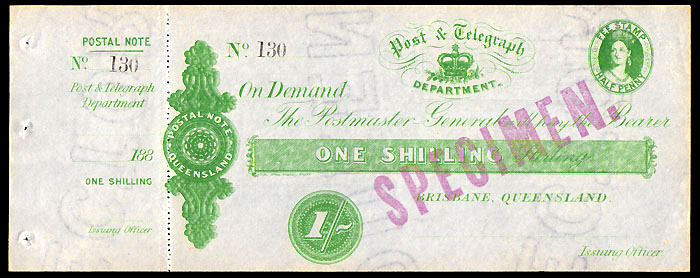 |
QC-TO-5B: Front side of Postal Note and Telegram transmission form numbered 130. Tab is at the left and attached with serrations. Watermark should be viewed from the back and reads from base to top. |
|
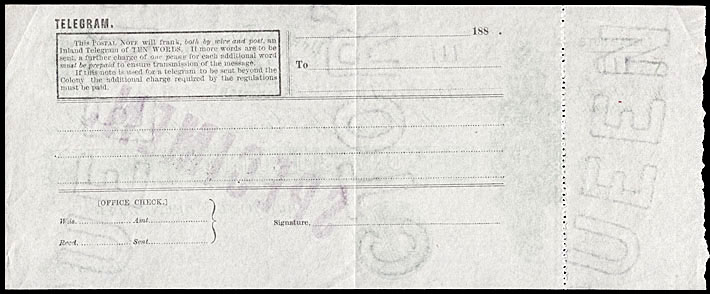 |
Reverse side of Postal Note and Telegram transmission form numbered 111.
Complete with tab. Shows part of the watermark [ELE]CTOR'[S] |
|
These forms were issued in a Booklet of 50 as shown below:
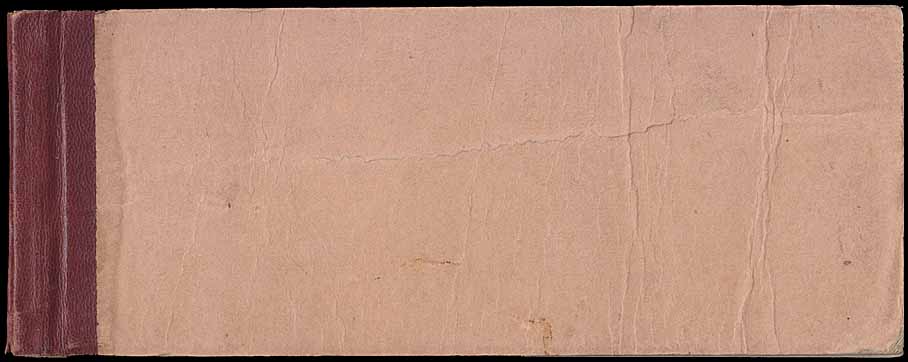 Closed booklet showing plain cover with no markings of any kind. |
Tabs shown at left with number 103 on top. The first form still included in complete form is 141 and it is followed by all forms to 149. This is the only known example of a still intact partial booklet. The known forms have no duplicate numbers and they are (as shown below) between 105 and 149. Spink September 2004 Lot 1320. At the time of that sale, the booklet contained 33
postal notes. |
The postal notes were of course also used for ordinary purposes and not just to pay transmission costs. There are no known notes used for telegraphic purposes as these would have been retained by the telegraph officials for accounting purposes. There are a few notes known with a date stamp which would have been sold to the public for ordinary use to transmit money.
The numbers hand stamped on the forms which have been recorded so far for the second printing of Postal Note are:
| Number | Description | Sale |
| 105 | No tab at left. | Status Auctions December 2006 - 2014. |
| 106 | Tab complete with holes. Perfect condition. |
Provenance: Dave Elsmore. |
| 111 | Tab is torn at left (no binding holes) but nearly complete. | Status Auctions February 2007 Lot 1579. |
| 112 | Tab complete with holes. Perfect condition. |
Provenance: Dave Elsmore. |
| 113 | No tab at left. | Status Auctions 2011-2014. |
| 117 | Tab complete with holes. Perfect condition. | Prestige Philately 2008 Sale 136, Lot 248. |
| 130 | Tab complete with holes where forms were sewn into the books of 20. | Ebay January 2011. |
| 131 | Tab complete with holes where forms were sewn into the books of 20. | Ebay March 2011. |
| 135 | Tab complete with holes where forms were sewn into the books of 20. | Ebay September 2011. |
| 136 | Tab complete with holes where forms were sewn into the books of 20. | Ebay April 2012; Prestige February 2014 Lot 389. Status May 2014 Lot 1569. Ebay July 2014. |
| 137 | Tab complete with holes where forms were sewn into the books of 20. | Ebay August 2012. |
| 138 | Tab complete with holes where forms were sewn into the books of 20. | Ebay November 2012. |
| 139 | Tab complete with holes where forms were sewn into the books of 20. | Ebay July 2013. |
| 141 - 149 | Complete and still bound into a booklet. | Prestige Philately, November 2014 (196) Lot 440. |
The third printing reverted to the original details onthe butt bound into the booklet:
- the Tab does NOT have the words POST & TELEGRAPH DEPARTMENT under the number;
- the Tab does NOT have the words Issuing Officer;
- there are serrations at the top and bottom of the notes;
The third printing of the 1/- postal note was made on paper with a different watermark. This second watermark showed QUEENSLAND above a Crown above POSTAL NOTE. The sheets measured ??? which enabled the printing of eight notes on each sheet in four rows of 2 notes. As with the first and second printings, the paper was fed into the machine with random orientation. |
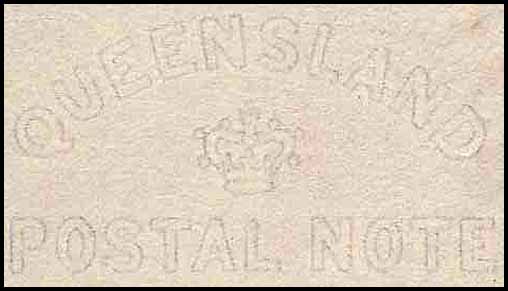 |
An example of a postal note from the third printing is shown below:
| Provenance: Dave Elsmore. | Isisford Printed on paper with the watermark of Queensland/Postal Note with Crown between. |
| Another 1/- Postal Note is also known. It has no SPECIMEN overprint and its number is quite different - 77860. It has a date stamp across the ½d fee stamp of "Kilkivan JA 26 92" (see Status Auction 236, December 2006, Lot 1519). | Kilikavan |
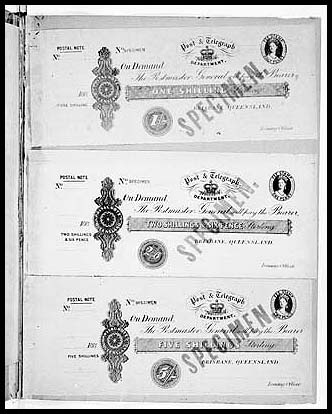 |
The official records show that the Postal Notes from the first and third printings were bound into books with all three denominations in each book - the denominations being 1/-, 2/6 and 5/-.
Only the 1/- Postal Note had the reverse side printed with telegraphic information.
Image from Australian National Archives |
Details of use and rarity.
| Form sub-number |
Schedule number | Earliest recorded date | Rarity rating |
| TO-5A | None | Not known used. | RR (with Specimen overprint) RRRR if with genuine date stamp. |
| TO-5B | None | Not known used. | |
| TO-5C | None | 12 April 1890 at Isisford. |
